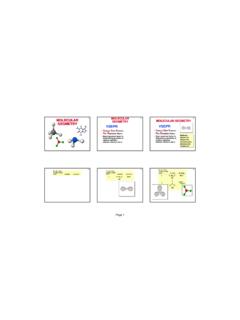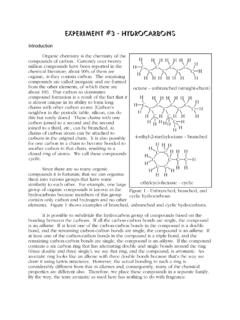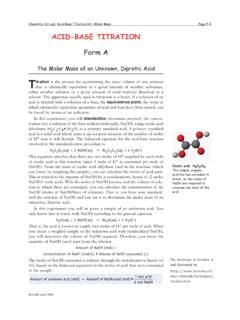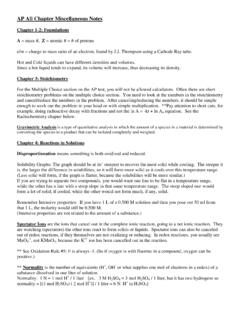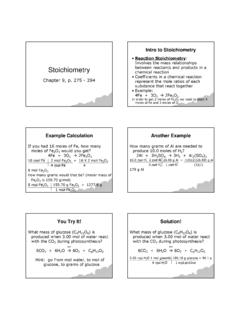Transcription of Chapter 4 Chemical Reactions and Solution Stoichiometry
1 Chapter 4 Chemical Reactions and Solution Stoichiometry 1 Chapter 4 Chemical Reactions and Solution Stoichiometry In This The science of chemistry brings three central benefits to society. First, chemistry helps explain how the world works, principally by examining nature on the molecular scale. Second, Chemical analysis is used to identify substances, both natural and artificial. This is evident every time a person s blood is tested to determine cholesterol level or when athletes undergo testing for banned drug use. Finally, the science of chemistry is unique in that it involves the ability to create new forms of matter by combining the elements and existing compounds in new but controlled ways.
2 The creation of new Chemical compounds is the subject of this Chapter . Here, we explore the different types of Chemical Reactions , emphasizing the Reactions that take place in aqueous Solution . Chapter Outline Types of Chemical Reactions Aqueous solutions Reactions in Aqueous Solution Oxidation Reduction Reactions Stoichiometry of Reactions in Aqueous Solution Chapter Review Chapter Summary Assignment Types of Chemical Reactions Section Outline Combination Reactions Decomposition Reactions Displacement Reactions Section Summary Assignment Chemical Reactions involve the transformation of matter, the reactants, into different materials, the products.
3 You have learned how to represent Chemical Reactions using balanced Chemical equations and how to calculate the quantities of material involved in a Chemical reaction. We will now investigate the three common types of Chemical Reactions : combination Reactions , decomposition Reactions , and displacement Reactions . Chapter 4 Chemical Reactions and Solution Stoichiometry - 2 - Opening Exploration Chemical Reactions Combination Reactions A combination reaction is one in which typically two or more reactants, usually elements or compounds, combine to form one product, usually a compound.
4 In one type of combination reaction, two elements combine to form a compound. For example, the elements hydrogen and oxygen combine to form water, giving off large amounts of energy in the process (Figure ) : 2 H2(g) + O2(g) 2 H2O(g) Figure Hydrogen burns in air to form water vapor. This combination reaction is used to generate power from the main engines in the space shuttle. The large fuel tank has separate compartments containing liquefied hydrogen and oxygen, which are vaporized prior to mixing. Other types of combination Reactions include the combination of an element with a compound and the combination of two different compounds to form a new compound.
5 For example, oxygen reacts with sulfur dioxide to make sulfur trioxide. 2 SO2(g) + O2(g) 2 SO3(g) Sulfur trioxide and water undergo a combination reaction to form sulfuric acid. SO3(g) + H2O( ) H2SO4(aq) Notice that in all combination Reactions , the number of reactants is greater than the number of products (Interactive Figure ). Chapter 4 Chemical Reactions and Solution Stoichiometry - 3 - Interactive Figure Explore combination Reactions . Zinc reacts with iodine to form zinc iodide. Decomposition Reactions In a typical decomposition reaction (Interactive Figure ), the number of products is greater than the number of reactants.
6 The reaction is essentially the reverse of a combination reaction and usually results from the addition of thermal or electrical energy. For example, water is a very stable compound under typical conditions, but it can be made to decompose to its constituent elements by using electrical energy, a process called electrolysis. 2 H2O( ) 2 H2(g) + O2(g) Metal carbonates such as calcium carbonate, CaCO3, undergo decomposition when heated, giving off carbon dioxide gas as one of the products. CaCO3(s) CaO(s) + CO2(g) Interactive Figure Explore decomposition Reactions .
7 The decomposition of mercury(II) oxide Chapter 4 Chemical Reactions and Solution Stoichiometry - 4 - Displacement Reactions Many common Chemical Reactions are classified as displacement Reactions , Reactions where the number of reactants is typically equal to the number of products. In displacement Reactions , also called exchange Reactions , one atom, ion, or molecular fragment displaces another. Displacement Reactions can be single or double Reactions . Single Displacement Reactions In a single displacement reaction, one molecular fragment is exchanged for another.
8 AB + X XB + A For example, when solid magnesium is placed in a Solution of copper(II) chloride, the magnesium displaces the copper. In this case, the more reactive metal, magnesium, replaces the less reactive metal, copper. CuCl2(aq) + Mg(s) MgCl2(aq) + Cu(s) Another common single displacement reaction occurs when a metal reacts with water. In the reaction of sodium metal with water, the metal displaces a hydrogen atom in water, forming sodium hydroxide (Figure ). H2O( ) + Na(s) H2(g) + NaOH(aq) Figure The displacement reaction between sodium metal and water.
9 Double Displacement Reactions A double displacement reaction, also called a metathesis reaction, occurs when two atoms, ions, or molecular fragments exchange. AB + XY AY + XB There are three common types of double displacement Reactions , each of which will be discussed in greater detail later in this Chapter . Precipitation Reactions are double displacement Reactions that result in the formation of an insoluble compound. For example, when aqueous solutions of lead nitrate and potassium sulfate are combined, solid lead sulfate is formed (Interactive Figure ).
10 Pb(NO3)2(aq) + K2SO4(aq) 2 KNO3(aq) + PbSO4(s) Chapter 4 Chemical Reactions and Solution Stoichiometry - 5 - Interactive Figure Explore displacement Reactions . Lead sulfate precipitates when solutions of lead nitrate and potassium sulfate are combined. Many acid base Reactions , also called neutralization Reactions , are double displacement Reactions that result in the formation of water. HCl(aq) + NaOH(aq) H2O( ) + NaCl(aq) The H+ and Na+ ions exchange to form the products, water and sodium chloride. Gas-forming Reactions , Reactions between ionic compounds and acids, are double displacement Reactions that result in the formation of a gas, often carbon dioxide (Figure ).

